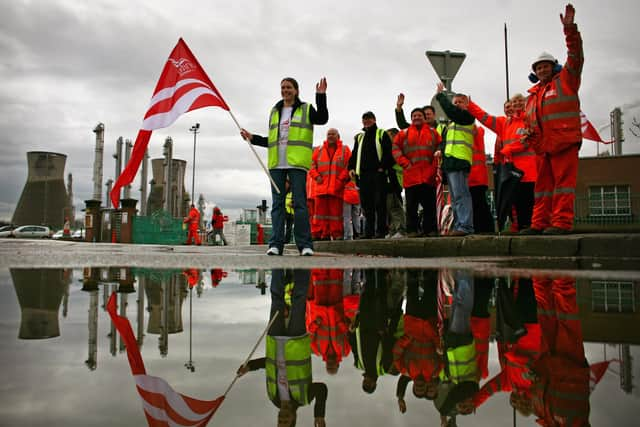Scottish cabinet papers highlight concerns over emergency planning during Grangemouth strike
It was an industrial dispute that led to panic at the forecourts and cost the economy hundreds of millions of pounds, but it was resolved before emergency measures were required. Now, newly declassified documents reveal just how ill-prepared authorities were in the face of strikes at the Grangemouth oil refinery.
The flashpoint in 2008 represented a major test for officials after around 1,200 workers walked out over a pension dispute, causing widespread disruption and sparking fears that the resultant shutdown would lead to gas shortages for homes and businesses across the country.
Advertisement
Hide AdAdvertisement
Hide AdThe scale of the crisis led to an unprecedented summit at Downing Street between Prime Minister Gordon Brown and First Minister Alex Salmond as their administrations sought to find a solution that would fend off public panic and fuel shortages.
But confidential documents, released by the National Records of Scotland (NRS), reveal that had the dispute escalated, there were serious concerns about the ability to enact a national emergency plan for fuel, which would have enabled ministers to control fuel supplies under a series of measures under the UK Energy Act 1976.
A meeting of the Scottish Government emergency room (SEER), a group that is activated in cases of national emergency or crisis, heard that the emergency plan at the time was “not fit for purpose,” with a “significant number of amendments made over the fortnight of the dispute to overcome potential difficulties.”
The SEER meeting, which took place in May 2008, said considerable blame lay with the then UK Department for Business, Enterprise and Regulatory Reform (BERR), but noted that there were failings at a devolved level too.
One document, entitled ‘Lessons identified from the Grangemouth industrial dispute,’ noted: “This indicates a lack of preparatory work and/or understanding of practical implications, primarily by BERR. However, Scottish stakeholders had also failed to highlight a number of concerns.”


Staff at the complex took part in a 48 hour strike that month amid a row over pensions, with the impact of the industrial action significant and widespread. Production was disrupted at several major North Sea fields, pushing up the price of oil, and leading to lengthy queues at petrol forecourts across the country after the closure of the Forties oil pipeline. Many stations limited customers to purchases of £10 or £20 worth of fuel, while several reported running out of diesel in light of the demand.
The dispute, which cost Ineos around £170m, was brought to an end after members of the Unite trade union voted to back plans that saw the firm leave its pension scheme open to new entrants, with members paying contributions.
The SEER meeting, overseen by a sub-committee of the Scottish cabinet, also addressed tensions within the Scottish Government’s emergency group. Another document released by the NRS pointed out that “those responsible for core functions within the SEER have reported pressure to become involved in non-core functions,” adding: “There are also concerns about the number of people in the SEER, their understanding of the response arrangements, and their role within them. Suggestions have also been made about improving training, leadership, and the maintenance of morale. All of these require further work.”
Advertisement
Hide AdAdvertisement
Hide AdThe document stated: “This was not an emergency but it did enable some aspects of the response to be trialled for the first time. It is probably true to say that had an emergency arien, some elements would have been severely stretched. Work is now underway to inject a greater degree of robustness in these areas.”
It also noted that there was a “divergence of view” between some areas of the UK and Scottish governments over what ‘consequence management’ meant. The result, the meeting heard, was that both administrations had an interest in monitoring shipping movements and fuel station outages, resulting in a duplication of effort.
Had the national emergency plan been enacted, the options available to ministers included imposing such as a maximum fuel purchase scheme, a commercial scheme prioritising road diesel supplies at truck stops, and various schemes which would have allowed blue light services, utilities services, local authorities, and public transport operators access to supplies.
But the SEER meeting also heard that a list of organisations to be covered by the two latter initiatives was “not comprehensive,” with “a significant number of requests for inclusion” either declined or filtered out.
An accompanying temporary logo scheme was also the subject of “some confusion” the minutes note, and its definition, initially confined to critical health and social care staff, had to be widened to include other agencies that perform life-saving functions. “In addition, the scheme did not initially allow access for subcontractors who work on behalf of critical organisations such as the blue lights and the utilities,” the minutes add. “Following discussions, the wording was changed to reflect this.”
The owners of Grangemouth, Scotland’s only oil refinery, announced in November that it could cease operations as soon as next year in the wake of significant challenges because of global market pressures. Petroineos, a joint venture between Chinese state-owned PetroChina and London-based INEOS, intends to turn the site into a fuels import terminal capable of handling petrol diesel, aviation fuel, and kerosene, a move that would result in the loss of at least 400 jobs.
Petroineos said the timescale for the transition had “not yet been determined,” but the work was expected to take about 18 months, and refinery operations were expected to continue until spring 2025.
Comments
Want to join the conversation? Please or to comment on this article.